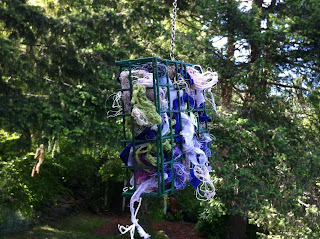The t-shirt has dried and been ironed and now it is time to leave it a little while longer before rinsing it for its final reveal ... but in the meantime, here are photos of the t-shirt
I am very pleased with the imprints achieved from the raspberry leaves and the purple Japanese maple. The smoke bush leaves were not as defined as usual, but they do add more to the overall imprint of the piece.
The background is a soft gold that will probably wash out a bit but I am delighted with this, my first attempt at eco printing on a finished garment.
Sunday, May 22, 2016
Friday, May 20, 2016
Eco Print T-shirt - Part II
Continuing on with the eco print t-shirt story . . .
The bundle rested for four days after being simmered, until I couldn't stand the suspense any longer and I opened the bundle.
The following photos show the bundle as I was unwrapping it ... first with both imprints and leaves showing and then with the leaves and plastic removed.
I am really pleased with how this has turned out and I will post a photo of the full shirt once it has dried.
The bundle rested for four days after being simmered, until I couldn't stand the suspense any longer and I opened the bundle.
The following photos show the bundle as I was unwrapping it ... first with both imprints and leaves showing and then with the leaves and plastic removed.
I am really pleased with how this has turned out and I will post a photo of the full shirt once it has dried.
Thursday, May 19, 2016
Eco Print T-shirt - Part I
I have been interested in trying to eco print on a finished garment . . . I see this as a challenge because of the finished seams and construction details (sleeves!) but also as a way of achieving a design on a specific part of the garment.
I purchased a plain inexpensive cotton t-shirt for this first attempt and I scoured it to remove impurities from the manufacturing process and then pre-mordanted it with alum and soda ash.
I chose leaves from which I could be sure of getting some imprint (raspberry, rose, Japanese maple and smoke bush) but I also added some unknown grasses along the lower edge.
In between the front and back of the shirt I inserted fabric that had been soaked in an iron-rich solution.
The shirt was rolled between layers of plastic onto a thick wooden branch and the outer edge was covered with plastic before being wrapped tightly. I then simmered the bundle in water with iron and onion skins for two hours.
I purchased a plain inexpensive cotton t-shirt for this first attempt and I scoured it to remove impurities from the manufacturing process and then pre-mordanted it with alum and soda ash.
I chose leaves from which I could be sure of getting some imprint (raspberry, rose, Japanese maple and smoke bush) but I also added some unknown grasses along the lower edge.
In between the front and back of the shirt I inserted fabric that had been soaked in an iron-rich solution.
The shirt was rolled between layers of plastic onto a thick wooden branch and the outer edge was covered with plastic before being wrapped tightly. I then simmered the bundle in water with iron and onion skins for two hours.
Tuesday, May 10, 2016
For the Birds
As people who work with fabric, we always have bits of thread and fabric hanging from our clothes and clinging to the furniture and carpets in our homes ... so I decided to take some of those bits and pieces and offer them to the birds!
This is the suet feeder that has kept our winter visitors well-fed during the colder months and it is usually put it away once the bears are roaming in the spring. This year I have filled it with thread waste and a few small trimmings from hand dyed fabric in hopes that some of the birds will use the bits for nest building.
I'll let you know if. Can get pictures of any of them taking say samples.
Subscribe to:
Comments (Atom)










